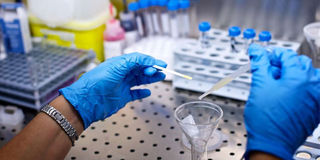The A to Z of in vitro fertilisation

Analysis of sperm pH before use in in vitro fertilisation. PHOTO| FILE
In vitro fertilisation (IVF) is a procedure whereby an ovum (egg) is fertilised by sperm outside the uterus.
The sperm and egg can come from the couple trying to conceive or from donors, if factors such as defects that cause infertility come into play.
According to Dr Joshua Noreh, a clinical embryologist whose clinic Nairobi IVF Centre handles 600 cases of assisted reproduction every year, 30 per cent require donor eggs or sperm from young, healthy and fertile donors, and normally, donor eggs are the ones required.
Egg and sperm donations are done voluntarily, and the donors usually learn that they can donate through the clinic’s website. The clinic gets about one donor every week.
The donors are taken through what it entails to be an egg or sperm donor, after which their health is assessed.
Rigorous tests to look for infectious diseases such as HIV, hepatitis B and C and syphilis are performed. Family history is also investigated to rule out the possibility of mental illness, diabetes, heart ailments that may run in the family, and other hereditary diseases. Results determine who will go on to be a donor and who will be disqualified.
Sperm donors are advised to abstain from sex for three days prior to the donation to ensure a good quality sample.
DONATION
The donor ejaculates into a sterile cup, and the sample is analysed to determine sperm count, motility and morphology (shape), which all determine the success rate of fertilisation. After testing, the sperm sample is frozen and stored in liquid nitrogen to preserve it for future use.
Egg donation is more intense. The woman is put on hormone-stimulating drugs for two weeks, starting from the second day of her menstrual cycle, to stimulate ripening of ova.
During ovulation, the donor is assessed and extraction is carried out. An egg donor is allowed up to four donations in her lifetime.
While the donors are not paid for their sperm and eggs, the clinics provide them with money for transport, accommodation and hospital bills, should they fall ill.
The donations are anonymous, meaning that the couple receiving the donated sperm or eggs will not know who donated them, and the donor will not know who received their eggs or sperms.
After retrieval, the eggs and sperms are fused in a petri dish, grown for a few days into embryos, then implanted in the recipient’s womb.
One or two embryos are implanted and any remaining embryos can be frozen for later use if another IVF cycle is needed. The implanted embryo(s) may lead to a pregnancy, or the procedure may be unsuccessful, meaning that the couple might have to try again. The success rate of IVF for women aged 35 years is about 40 per cent during the first IVF cycle.
Kenya has about 2,000 IVF babies according to Dr Wanyoike Gichuhi, a senior lecturer in the Department of Obstetrics and Gynaecology at the University of Nairobi.



